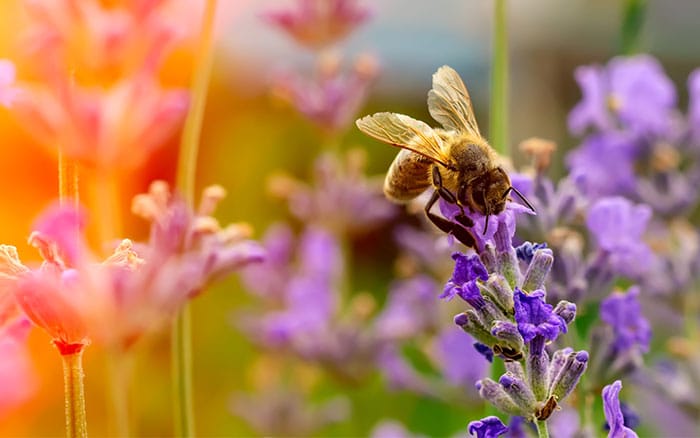By ensuring our gardens are a welcoming and safe space for wildlife, we are having a positive impact on declining populations. There are an estimated 24 million gardens in the UK. So there is plenty of space for our neighbourhoods to be packed with fluttering butterflies, humming bees and – if you’re lucky – hedgehogs, amphibians and beetles. By helping them, you are introducing an eco-system into your garden that will benefit your plants.
Busy bees and beautiful butterflies
Bees and butterflies are an important part of our eco-system. They pollinate food crops, homegrown flowers and wild plant species on which other wildlife depends. But populations of some bees and butterflies are in real decline due to loss of habitat and use of pesticides.
If we garden with pollinators in mind, we can offer them a nutritious platter of pesticide-free nectar and pollen that will increase their numbers for years to come. Here’s what you can do:
• Plant pollinator-friendly early and late-flowering plants to feed pollinators in the later months of the year. Galanthus nivalis (common snowdrop), Ribes Sanguineaum (flowering currant) and Digitalis (foxgloves) are all great options.

• Purple flowers are generally a favourite for bees, such as Muscari Neglectum (grape hyacinth) and Crocus (Crocus). These are often the first flowers to appear in spring and bees love them. Look out for RHS’s ‘Plants for Pollinators’ logo which will help you identify plants for wildlife like bees and butterflies.
• Take care with pesticides. Avoid ‘systemic’ or ‘translocated’ pesticides, which get into nectar and pollen and harm pollinators. If using other kinds, don’t spray plants that are in open flower to help limit contact with pollinators or use nonchemical sprays like detergent or neem oil.
• Provide an inviting bee hotel for solitary bees such as mason, leafcutter and yellow-faced bees, that nest in hollow stems. The female mason will lay their eggs in the hotel, which will emerge as young bees the following year.

Happy hedgehogs
Hedgehogs can be brilliant for your garden, as they eat slugs and snails, making them protectors our prize blooms. These creatures need neighbourhoods of linked-up gardens to get around, so here are a few ways to adapt your garden:
• To ensure hedgehogs have access to all the food they need, cut a 13cm2 hole in the bottom of your garden fence or replace them with hedgerows as permeable boundaries, to allow hedgehogs to roam freely.
• Provide sheltered space in the form of a hedgehog house as a safe space to raise litters of hoglets. A log pile or a simple space under a shed with dry leaves and straw will offer a cosy place for them to stay.
• Leaving out food and fresh water will keep hedgehogs coming back for more. A perfect offering is tinned cat and dog food, or purchase specialist hedgehog food from a garden centre. Place the food in your garden at dusk and clear any leftovers in the morning.

Amiable amphibians
Having a pond in your garden will attract a variety of amphibians including frogs, toads and newts. The benefit of this is that they will clear your pond of algae and eat pests like slugs and snails, so your plants are safe.
• You can build a pond at any time during the year but starting in autumn or late winter means it will thrive quicker. No matter what the size of your garden is, a pond of any variation is still incredibly valuable for wildlife.
• Ensuring your pond has a ramp or gradual steps will allow wildlife to access the pond for food and escape if they need to climb out. To make the pond accessible for different species, have a shallow section for toads and a deeper section for frogs and newts.
• Bog gardens allow dry and wet eco-systems to be linked within one area and can be created by converting an existing pond or adding bog area to new pond. Mix up short and tall bog plants like ground-hugging Lysimachia nummularia (creeping jenny) and proud Iris ensata (Japanese water iris), for maximum impact.

Beneficial beetles
Many of the above adjustments are also valuable to attract beetles to your garden, but there are a couple of things that you can do to entice them further.
• Spreading leaf litter or organic mulch, like bark chippings, through garden borders will provide egg-laying sites for beetles. Beetles love a damp environment, so it is helpful to mulch plants that you water regularly, like Hostas, to accommodate this.
• Whether growing your own produce or aiming for a stunning spectacle of flowers, beetles should be protected as they are voracious predators that love slugs and snails.

By following these tips to attract and support wildlife in your garden, you are providing a safe and welcome environment for many species. You will have a thriving eco-system on your doorstep that will help support your plants.

Leave A Comment